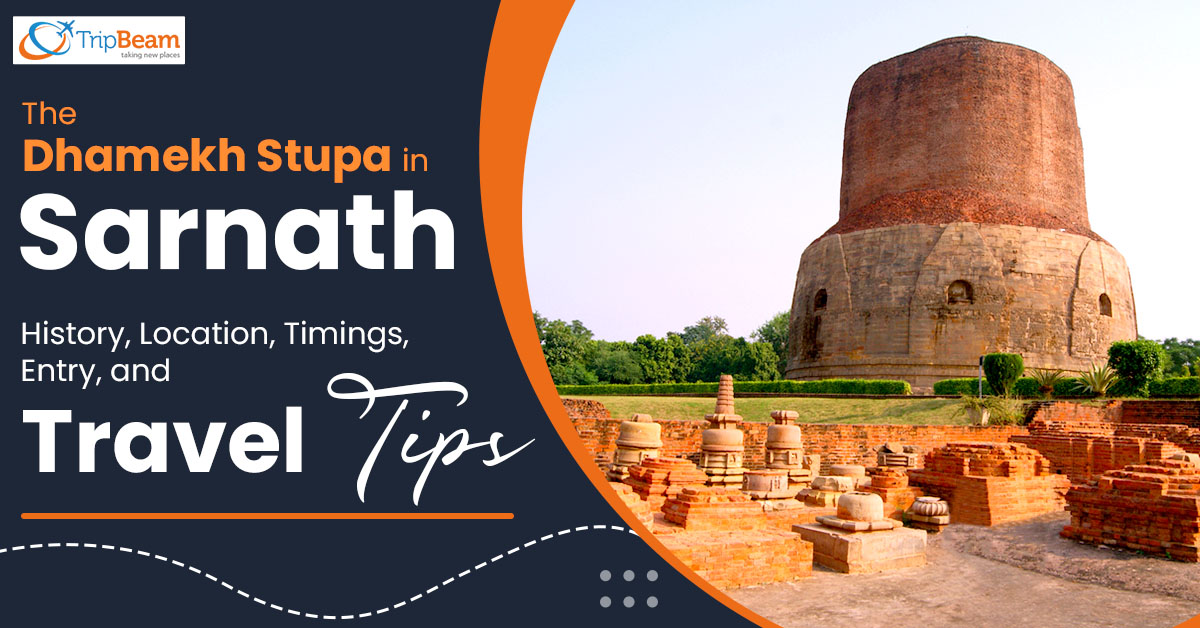

Dhamek Stupa is one of Sarnath’s most famous sites since it symbolises the place where Lord Buddha presented the first sermon to His five disciples after achieving enlightenment in Bodh Gaya. Several ancient texts report that the first sermon took place at a location known as “Mriga-Dayaa-Vanam,” or animal sanctuary. Following Lord Buddha’s parinirvana, his mortal remains were incinerated, the ashes split, and buried behind eight mounds, plus additional mounds wrapping the urn and flames. Researchers have limited knowledge about these early stupas, particularly due to the challenge of identifying the original ten monuments. On the other hand, some later stupas, like those at Sarnath and Sanchi, appear to be additions to older mounds.
Come and explore this monument with us, book your cheap flights to India from Canada now. Visit Tripbeam to book your flight tickets and get the most affordable deals.
After Lord Buddha’s passing, his remains were divided and buried under 8 mounds, with ashes and an urn placed under 2 more, totalling 10 monuments. Despite the limited information available, legends believe that the Stupas at Sanchi and Sarnath expanded upon these original mounds. Emperor Ashoka, ruling from c. 268 to 232 BCE, built numerous Stupas across India to promote Buddhism. In 249 BCE, he commissioned the Dhamek Stupa in Sarnath, later reconstructed in 500 CE. Chinese monk Xuanzang visited in 640 CE, recording the stupa’s height as 91 m and noting 1500 priests in the colony.
The Dhamek Stupa stands as a cylindrical structure, towering nearly 44 meters tall with a diameter of 28 meters. Crafted from red brick and stone, builders meticulously covered the entire lower portion with exquisitely cut stones, adorned with magnificent floral decorations dating back to the Gupta era. Skilled artisans expertly sculpted human and bird designs around the edges of the stupa. Its foundation dates back to the Ashokan era, with “Swastikas” adorning the panels. Throughout history, the stupa has undergone approximately 12 expansions and enlargements.
Entering the Dhamek Stupa is prohibited for tourists. Dhamek Stupa’s interior is off-limits to the general public. One of the stupa’s purported features is a relics room that once housed an expensive Buddha artefact. Sadly, there is no longer access to this historic room. So, it is not clear what is inside.
The months of October through March are ideal for visiting Dhamekh Stupa because of the lovely mild temperature throughout this time. You can access the location from morning through dusk and it remains explorable at any time of year. Entry costs per person for Indian nationals and visitors from SAARC and BIMSTEC countries are Rs. 5/-, while others are Rs. 100/-. Also, if you’re looking your way to India from the USA, you can opt for Tripbeam.com as your ticket booking partner.
Including the Chaukhandi Stupa, the Mulagandhakuti Vihara, and the Sarnath Archaeological Museum, along with the Dhamekh Stupa, Sarnath is the place of many significant Buddhist sites. Each site offers a distinct window into the life of Buddha and early Buddhist history. Book your advance Business-class flight tickets to India today to explore Sarnath.
The Dhamekh Stupa in Sarnath is a sincere manifestation of Buddha’s teachings. With convenient hours and timeless appeal throughout the year, it provides a rewarding visit for tourists. Plan your trip to Sarnath, engage yourself in the mystical aura, and experience the everlasting tradition of Buddhism. Book your last-minute flights from Canada to India with Tripbeam for a seamless travel experience.
Also read: One Day in Lucknow: A Glimpse of Uttar Pradesh’s Capital
Tell us more details to help better





